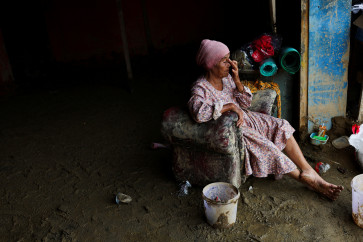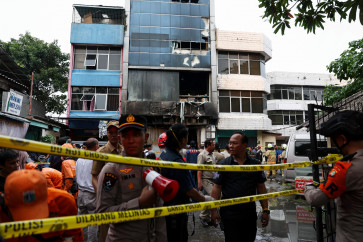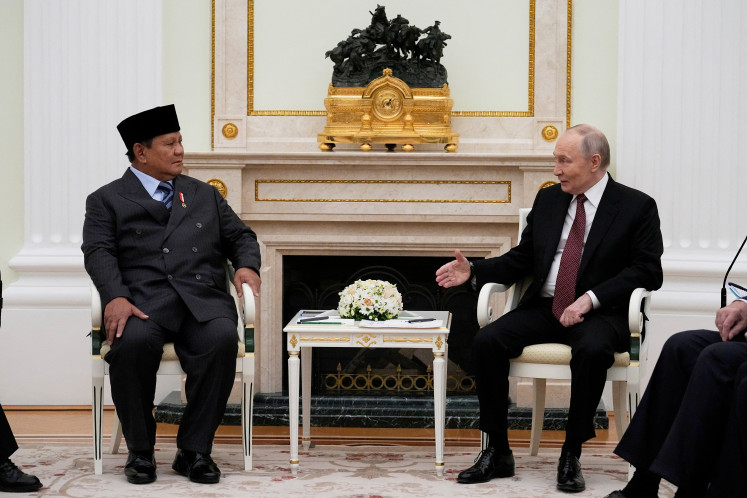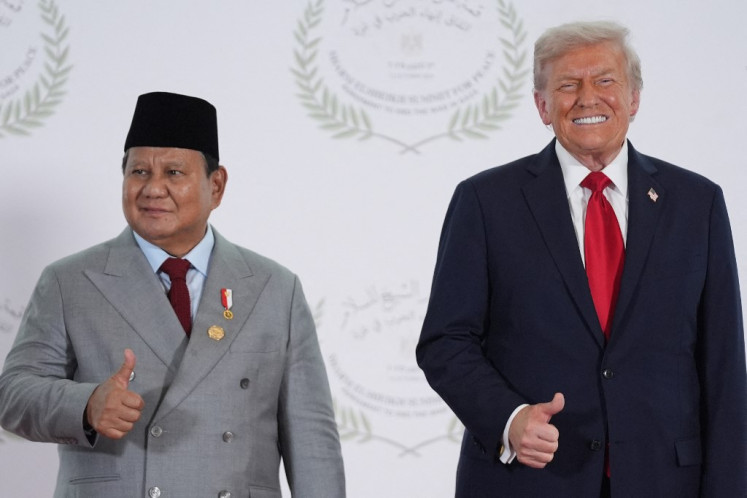Popular Reads
Top Results
Can't find what you're looking for?
View all search resultsPopular Reads
Top Results
Can't find what you're looking for?
View all search resultsDanarsih Santosa: Batik is more than just fabric
The ink used in batik must run through Danarsih Santosa’s blood
Change text size
Gift Premium Articles
to Anyone
T
he ink used in batik must run through Danarsih Santosa’s blood. She was born into a batik-making family, spent her childhood working for her parent’s batik company, and now runs her own batik business, employing no less than 10,000 employees.
JP/GANUG NUGROHO ADI
When she was still at elementary school in the 1950s, she joined the ranks of batik workers at her parent’s business immediately after school. Danarsih prepared the wax herself and the equipment for making batik.
On other occasions, young Danarsih sold batik clothes, hawking them from home to home. And when she entered junior high school, Danarsih began studying batik design, product management and sales administration.
“My childhood up to my teenager years was spent in the batik workroom. I seldom had time to play like other kids of my age. Anyway my interest was batik, batik, and batik,” recalled the mother of four children.
Danarsih’s batik family hails from Surakarta, Central Java. Her parents were batik entrepreneurs even though they only ran a humble business.
Apparently the fruit did not fall far from the tree. After she graduated from State Senior High School 1 Margoyudan at Solo, Danarsih continued studying at the School of Chemical Engineering at Gajah Mada University (UGM) in Yogyakarta.
In between her studies, the woman who was born in Solo on September 26, 1946, would return to Solo on weekends to pursue her childhood hobby, namely selling batik cloth. Then on Monday she would head back to Yogyakarta where she brought merchandise.
“A lot of college friends teased me, calling me a bakul [merchant]. I just ignored them. Gradually they even became my clients. Many lecturers also ordered batik from me.”
But the September 30 Movement (Gestapu) coup d’etat in 1965 forced Danarsih to go back to Surakarta and interrupt her studies. Her parents didn’t want her to live in other towns during those uncertain political times.
Danarsih studied for the two years at the School of Law at the University of Saraswati, Surakarta, before she finally met Santosa Doellah and married him. Her marriage to Santosa marked the beginnings of her career in the batik business.
In 1968, she and her husband started their batik business, which was later called Batik Danar Hadi.
Their pioneering product was the manufacturing of Batik Wonogiren, recreating the classic motif of the palace (Pura Mangkunagaran).
However the wheels of the Danar Hadi batik business did not always run smoothly. Danarsih experienced tough times when Chinese batik using printing technology penetrated the Indonesian market, particularly in Surakarta, during the early 1980s.
Many Indonesian consumers turned to printed batik, mass produced and cheap. Danar Hadi wasn’t the only business to feel the pinch. Other batik entrepreneurs in Surakarta (Kauman Batik Kampong and Laweyan Batik Kampong) were also shaken, with some choosing to shut down their businesses because they were unable to compete with mass-produced products.
“Once I had to get rid of employees because the market for local batik had been killed. But we thought hard about finding the trick to break the market,” said Danarsih.
It was lucky the government responded immediately, she went on, by banning Chinese batik imports.
The damage was nevertheless done, and the local batik industry found it difficult to recover.
“The 1980 to 2000 period was a difficult time for the batik industry here, especially for small to medium businesses [SME],” said the woman whose collection of batik includes over 10,000 ancient pieces, some of which are hundreds of years old.
In 1975, Danarsih enlarged her business by opening a small shop in Jakarta. She worked with fashion consultants including Harry Darsono and Prayudi. Later she opened outlets in Bandung, Medan, Surabaya, Yogyakarta and Semarang.
Danarsih successfully developed her upstream business in 1981 by establishing a weaving and finishing business. She then opened a garment business, the Kusuma Putri Company, in 1989.
After running her Danar Hadi businesses for more than 40 years, Danarsih succeeded in creating a batik empire: One of the largest batik companies in the country with 20 outlets spread across major cities in Indonesia.
She rejoiced when the United Nations Educational, Scientific and Cultural Organization (UNESCO) in October 2009 classified Indonesia’s batik as part of the world’s cultural heritage.
“Batik-making was my childhood dream. It must not only be preserved, but must also be developed. Batik is part of the nation’s cultural identity,” she said.
And it seems she is not worried about Chinese batik flooding Indonesia now that the China-ASEAN free trade agreement has come into being.
“What is being imported from China is not batik, but textile. So we shouldn’t be worried. Our society is smart enough and knows how to distinguish good batik from copies,” she said.
Now that her businesses are thriving, Danarsih is more involved in social activities. If she has to deal with batik, she focuses on creating designs and motifs.
At the moment, Danarsih and her husband are getting help from their children. Diana Santosa, their second daughter, is now managing director of the Danar Hadi Company. Meanwhile one of their other children, Dewanto Santosa, handles the company’s Finances.
In her social activities, Danarsih has joined the Women’s International Club (WIC) in Surakarta
as well as the Rotary Club. She is partakes in pengajian (joint recitation of the Koran) with women
and the Amal Sahabat Surakarta Foundation.
Danarsih has been appointed as head of the Ratna Clothing Association in Surakarta, an organization concerned about women in Solo being able to dress in a traditional way.
“When we grow older, we tend to shift our focus towards more socially oriented activities. Many people around us need help. I want to help them. Our lives will benefit if we can help other people,” she said at the Sogo Resto n ‘ Lounge at Slamet Riyadi Street, Surakarta.
In her spare time, Danarsih and her husband continue to manage the Danar Hadi Batik Museum, which holds around 10,000 samples of ancient batik cloth. Danarsih has been collecting samples of ancient and rare batik for more than 30 years.
As many as 1,500 samples of batik were sourced from the private collection of Troupen Museum’s curator in the Netherlands. These batik were made between 1840-1910.
Other collections come directly from the four palaces in Surakarta and Yogyakarta, namely the Kasunanan Surakarta Palace, Kasultanan Yogyakarta Palace, Pura Mangkunegaran, and Pura Pakualaman. Her most precious pieces include the liris breast cloth from the collection of the Queen Sri Sultan Hamengku Buwono VII, and the Lereng Huk batik from the Pura Pakualaman.
“This museum was established because batik is not just a sheet of cloth. Every batik cloth is a repository of culture with historical values, tradition and philosophy. That’s why batik should be preserved,” said the elegant woman.










